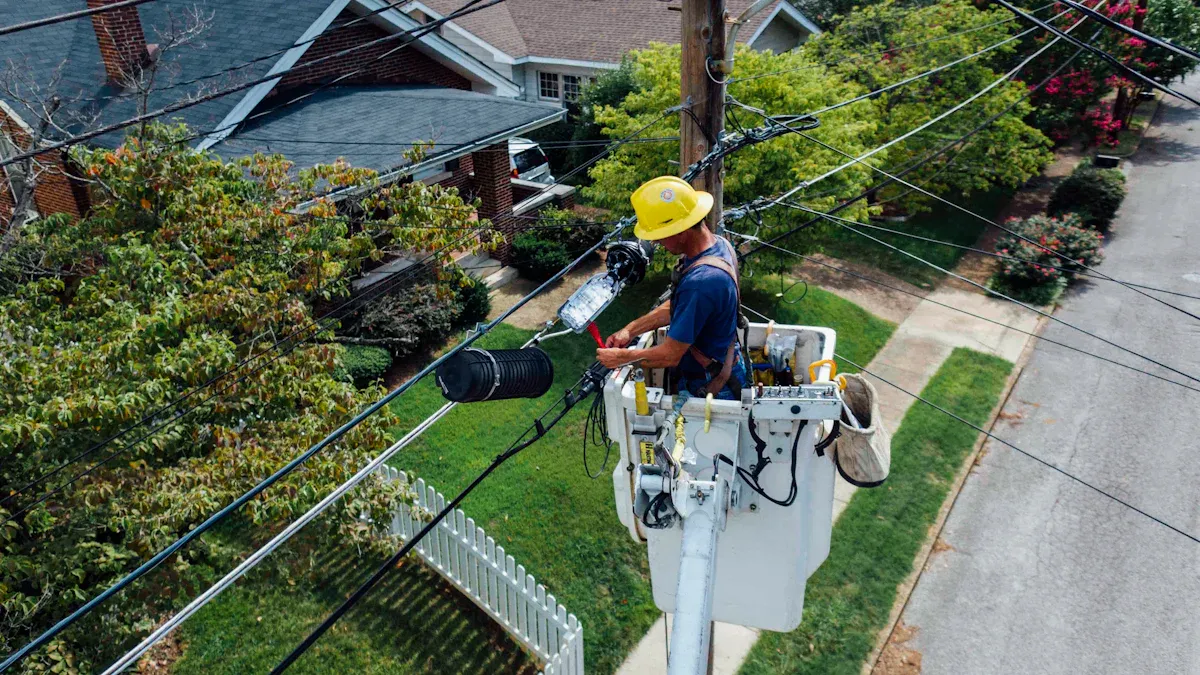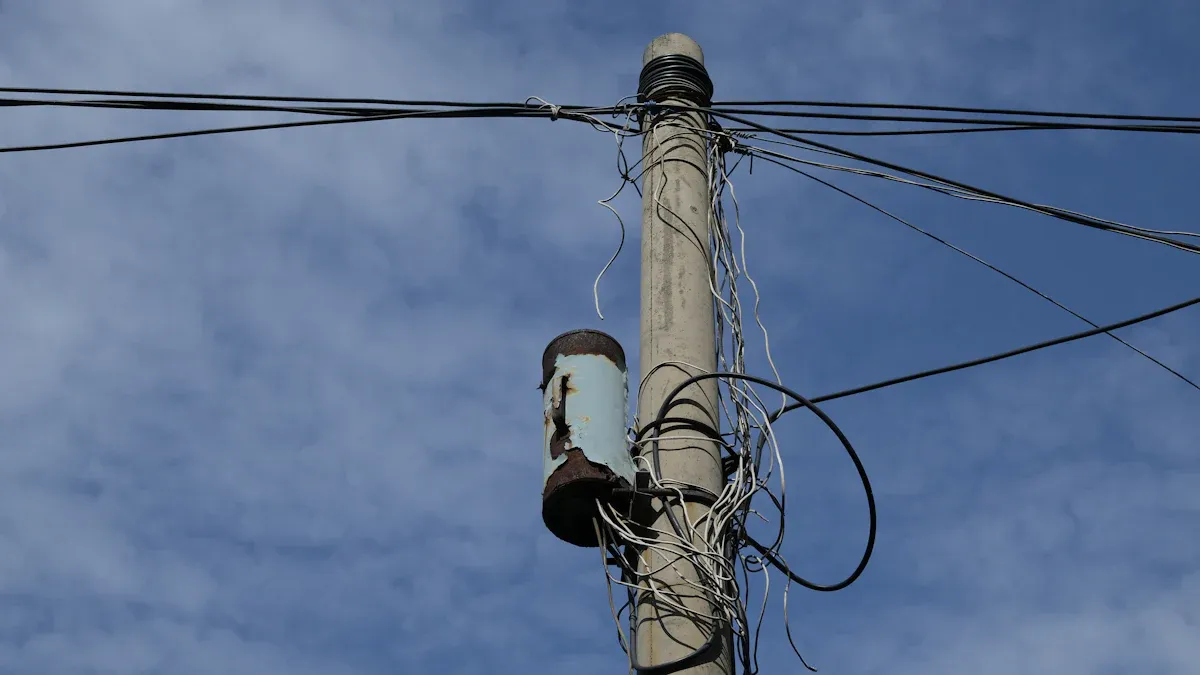
ADSS clamps serve as essential components in high-voltage installations, ensuring secure and stable cable connections. Their lightweight design simplifies handling, reducing physical strain during setup. These clamps, including the adss suspension clamp and adss tension clamp, as well as the adss cable clamp, prevent cable sagging or snapping, minimizing risks in telecom networks. Durable construction allows them to withstand harsh conditions, ensuring long-term reliability. By prioritizing safety and efficiency, technicians can optimize performance while reducing maintenance needs. This checklist offers a practical guide to streamline the installation of ADSS fittings, ensuring safety in high-voltage environments.
Key Takeaways
- Check the site carefully before starting to find dangers and plan well. This helps keep everyone safe and makes work faster.
- Make sure all tools and materials match and follow rules. This avoids problems and makes the setup easier.
- Always use safety gear and harnesses while working. This lowers the chance of accidents and keeps workers safe.
Pre-Installation Preparation for ADSS Clamp

Conducting a Comprehensive Site Survey
A comprehensive site survey is the foundation of a safe and efficient installation process. It helps identify potential hazards, such as underground utilities or contaminated soil, which could pose risks during construction. By addressing these issues early, technicians can implement mitigation strategies to ensure safety and minimize environmental impacts. Additionally, site surveys provide valuable insights into terrain conditions, enabling teams to plan the installation of ADSS Clamp systems effectively. This proactive approach reduces delays and enhances overall project efficiency.
Verifying Materials, Tools, and Hardware
Thorough verification of materials, tools, and hardware ensures a smooth installation process. Industry standards emphasize the importance of Installation Qualification (IQ), Operational Qualification (OQ), and Performance Qualification (PQ) to confirm that equipment meets specifications, operates correctly, and performs as intended. Hardware checks are particularly critical, as they prevent the use of incompatible components. For example, verifying that the ADSS Clamp matches the cable type avoids potential failures during operation. These steps ensure reliability and safety in high-voltage environments.
Preparing Installation Equipment and Safety Gear
Proper preparation of equipment and safety gear is essential for worker protection and installation success. All tools and machinery must be inspected for functionality and compliance with safety standards. Disqualified equipment should be removed immediately. Safety gear, including helmets, gloves, and harnesses, must be provided to all workers. Maintaining these precautions ensures that the installation process adheres to industry safety protocols while reducing the risk of accidents.
Conducting Worker Training and Safety Briefings
Worker training and safety briefings play a vital role in preventing accidents during ADSS Clamp installations. Training sessions should cover the correct handling of cables, proper use of tools, and adherence to safety measures. Safety briefings before each shift reinforce these practices and address site-specific risks. By equipping workers with the necessary knowledge and skills, teams can ensure a safer and more efficient installation process.
Step-by-Step Installation Process for ADSS Clamp
Proper Handling and Placement of ADSS Cables
Proper handling of ADSS cables ensures their longevity and performance. Technicians should inspect supporting poles for structural integrity before installation. Cables must be handled carefully to prevent damage, such as kinking or bending beyond the recommended radius. For instance, the minimum bending radius during installation should be at least 20 times the cable diameter, while during operation, it should be at least 10 times the diameter.
To maintain performance, cables should be tensioned correctly and installed using compatible hardware. Lightweight ADSS cables are ideal for installations near electric wires, but planning accessible routes and appropriate span lengths is crucial. Additionally, sealing cable ends with waterproof tape prevents moisture ingress, safeguarding the system in varying environmental conditions.
Setting Up and Aligning the Hardware
Aligning hardware accurately is critical for the safe and efficient installation of ADSS Clamp systems. According to IEEE standards, three-dimensional electric field analysis helps identify corona risk areas, which can be mitigated through proper design adjustments. Hardware alignment must also account for maintaining adequate distances to prevent arcing, especially in high-voltage environments.
Technicians should ensure that all components, including armor rod assemblies and dampers, are securely anchored and aligned. This prevents equipment failure and enhances the overall stability of the installation. Regular inspections during setup help verify that all hardware meets the required specifications.
Securing the ADSS Clamp to the Cable
Securing the ADSS Clamp firmly to the cable is essential for system reliability. The installation process involves several steps:
- Adjust the cable tension and ensure the internal layer reinforcing rods are even.
- Mount the outer layer preformed rods symmetrically, aligning them with the middle mark.
- Install the thimble clevis at the marked position on the rods.
- Attach the first U-shaped ring, followed by the extension link.
- Secure the second U-shaped ring to connect the assembly with the pole or tower fasteners.
This method ensures the ADSS Clamp remains stable under various environmental conditions, including high humidity, freezing temperatures, and heavy snow.
Tensioning the Cable to Meet Safety Standards
Tensioning the cable correctly is vital for maintaining safety and performance. Technicians should follow the manufacturer’s recommendations to achieve the appropriate tension levels. Excessive tension or pressure can compromise the cable’s structural integrity, while insufficient tension may lead to sagging.
Weather conditions, such as wind and temperature, should also be considered during tensioning. For example, cables in coastal regions must withstand high humidity and salt exposure, while those in mountainous areas require tensioning to handle freezing temperatures and snow loads. Proper tensioning ensures the ADSS Clamp system operates reliably over its lifespan.
Essential Safety Measures During ADSS Clamp Installation
Wearing Protective Gear and Safety Harnesses
Protective gear and safety harnesses are essential for ensuring worker safety during ADSS Clamp installations. Helmets, gloves, and insulated boots shield workers from potential hazards, such as falling debris or electrical shocks. Safety harnesses provide additional security when working at heights, reducing the risk of falls. Technicians must inspect all safety equipment before use to confirm it meets industry standards. Properly fitted gear enhances mobility and comfort, allowing workers to focus on the task without compromising safety.
Maintaining Safe Distances from High-Voltage Lines
Maintaining safe distances from high-voltage lines is critical to prevent accidents. The following table outlines the recommended clearance distances based on voltage levels:
| Voltage Level | Safe Distance |
|---|---|
| 50 kV or less | At least 10 feet |
| Above 50 kV | At least 35 feet |
To ensure compliance, teams should designate an observer to monitor the distance between equipment and power lines. Only authorized personnel can de-energize or relocate power lines, making pre-installation planning essential. Proper coordination minimizes risks and ensures a smooth installation process.
Inspecting Tools, Materials, and Hardware
Regular inspections of tools, materials, and hardware are vital for safety and efficiency. Defective items can disrupt operations, compromise quality, and increase accident risks. Inspections help identify potential hazards, maintain equipment longevity, and prevent injuries. Comprehensive inspection guides emphasize the importance of routine checks, which significantly reduce workplace accidents and improve operational effectiveness.
Monitoring Weather and Environmental Conditions
Weather and environmental conditions play a significant role in the safety of ADSS Clamp installations. High winds, rain, or extreme temperatures can create hazardous working conditions. Technicians should monitor forecasts and adjust schedules accordingly. For example, installations in coastal areas must account for high humidity and salt exposure, while mountainous regions require preparations for freezing temperatures and snow. Adapting to environmental factors ensures worker safety and system reliability.
Post-Installation Checks for ADSS Clamp
Inspecting the Installed Clamp and Cable Alignment
Inspecting the installed ADSS Clamp and cable alignment is essential for ensuring long-term stability and safety. Technicians should verify that the clamps securely hold the cables without causing damage. Misaligned clamps can reduce the system’s safe working load, increasing the risk of failure. Regular inspections help identify potential issues early, preventing cable sagging or snapping.
- Best practices for inspection include:
- Ensuring the ADSS Clamp is properly positioned and tightened.
- Verifying that the cable’s bending radius adheres to manufacturer guidelines.
- Confirming that tension and pressure loads are within safe limits to protect the optical fibers.
These steps ensure the system remains reliable under harsh environmental conditions, such as UV exposure or corrosion.
Testing the System for Stability and Performance
Testing the system after installation validates its stability and performance. Technicians should conduct tensile load tests to confirm the clamps can withstand the specified slip load. For example:
| Case Study Description | Outcome |
|---|---|
| Deployment in coastal regions with high humidity and salt exposure | Resisted corrosion and maintained a firm grip |
| Use in a windy coastal area by a telecommunications company | Demonstrated durability and secure cable support despite challenging conditions |
A step-by-step testing process includes:
- Preloading the cable to 67 N/leg and setting the load rate to 222 N/min.
- Loading to the manufacturer’s minimum slip withstand rating and holding for one minute.
- Increasing the load until continuous slip occurs and recording the results.
These tests confirm the system’s ability to perform reliably in diverse environments.
Documenting the Installation Process Thoroughly
Thorough documentation of the installation process ensures compliance with industry standards and provides traceability. Key elements to include are:
- Equipment identification details, such as model and serial numbers.
- Environmental conditions during installation, including temperature and humidity.
- A checklist of verified installation criteria.
Accurate records support investigations of deviations and enable corrective actions. Implementing clear procedures and conducting regular audits further enhance documentation quality.
Scheduling Routine Maintenance and Inspections
Routine maintenance and inspections are critical for preserving the system’s integrity. Technicians should establish a schedule based on environmental factors and usage conditions. Regular checks help identify wear and tear, ensuring timely repairs or replacements. For instance, clamps exposed to coastal humidity may require more frequent inspections to prevent corrosion. Proactive maintenance extends the lifespan of the ADSS Clamp system and minimizes downtime.
Following the ADSS Clamp installation checklist ensures safety and efficiency in high-voltage environments. High-quality products, such as Dowell ADSS clamps, provide reliable performance and long-term stability. Adhering to safety protocols minimizes risks and enhances system durability. These practices not only protect workers but also ensure the installation meets industry standards.
FAQ
What is the recommended safe distance from high-voltage lines during installation?
Technicians should maintain at least 10 feet for voltages up to 50 kV and 35 feet for higher voltages. This ensures worker safety and prevents electrical hazards.
How often should ADSS Clamp systems undergo maintenance?
Routine maintenance should occur based on environmental conditions. For example, coastal installations may require inspections every six months to prevent corrosion and ensure system reliability.
Can ADSS Clamps withstand extreme weather conditions?
High-quality ADSS Clamps, like Dowell products, are designed to endure harsh environments, including freezing temperatures, heavy snow, and high humidity, ensuring long-term performance and stability.
Post time: Mar-31-2025
